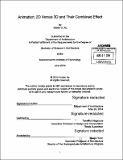Animation : 2D versus 3D and their combined effect
Author(s)
Au, Kristin C
DownloadFull printable version (9.268Mb)
Other Contributors
Massachusetts Institute of Technology. Department of Architecture.
Advisor
Takehiko Nagakura.
Terms of use
Metadata
Show full item recordAbstract
This thesis studies the differences in the perception of space and character movement between 2D and 3D animation. 2D animation is defined by elements constructed in a 2D environment while 3D animation by elements constructed in a 3D environment. Modern day animated films have been seen to mix the two forms for the sake of artistic effect, expedited production, and general convenience. Though some modern animations combine the two in the explorative quest to discover new animation forms, few films directly compare the forms to visualize the differences in their perceived qualities. Noticeably, the two animation methods differ in level of detail, dimension, realism, and artistic expression. In terms of lighting, the science of illumination dictates the 3D environment whereas in the 2D environment, lighting is an illusion created by coloring conventions. This study looks specifically at lighting as the controlling factor delineating the two forms. Two short mixed media films were created. One film had a 3D base while the other a 2D base. A varied set of subjects were shown one of the two short films produced and asked to complete a survey. The survey measured the subject's understanding of space and character movement as seen the film. Results show that in 3D there is an enhanced understanding of spatial perception while in 2D there is a lower sensitivity to character movement.
Description
Thesis: S.B., Massachusetts Institute of Technology, Department of Architecture, 2014. Cataloged from PDF version of thesis. Includes bibliographical references (pages 53-54).
Date issued
2014Department
Massachusetts Institute of Technology. Department of ArchitecturePublisher
Massachusetts Institute of Technology
Keywords
Architecture.